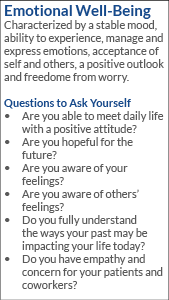 The VITAL WorkLife Wheel of Well-Being is a tool used to evaluate distinct areas of life and build overall well-being through improving each dimension of well-being. Your overall well-being is made of multiple dimensions. The Emotional Well-Being is one dimension contributing to your holistic health; you cannot achieve overall well-being without having balance in each of the dimensions.
The VITAL WorkLife Wheel of Well-Being is a tool used to evaluate distinct areas of life and build overall well-being through improving each dimension of well-being. Your overall well-being is made of multiple dimensions. The Emotional Well-Being is one dimension contributing to your holistic health; you cannot achieve overall well-being without having balance in each of the dimensions.
Emotional Well-Being
At VITAL WorkLife, we define Emotional Well-Being as:
"The ability to recognize and regulate one's emotions, utilize interpersonal skills to communicate effectively, while practicing stress management, self-care, mindfulness and resilience."
But How Can You Achieve and Maintain Emotional Well-Being?
Everyday emotional well-being involves utilizing your strengths rather than focusing on fixing problems or weaknesses. The better you are able to master your emotions, the greater your capacity to enjoy life, cope with stress and focus on important personal priorities.
 What Contributes to Emotional Well-Being?
What Contributes to Emotional Well-Being?
Many factors contribute to emotional well-being, including genetics, exposure to sunlight, diet and exercise, resiliency, what you spend time thinking about, relationships and relationship skills, overall health, life experiences, meaning and purpose, and more. As you can see, there are many areas available to you to work on if you are interested in improving your emotional well-being. Even though you may have limited control in some areas, other areas are well within your control.
Case Study
John lives in a part of the country with very limited sunlight during the winter. He also is genetically predisposed to depression and has had several significant losses in his life.
We might imagine John would not have emotional well-being. On the contrary, John recognized he would need to invest time and energy into taking care of this part of his life, especially considering those factors he was up against.
John purchased a special lamp to help provide more light during the winter months and improve his mood. He also makes a point of taking a multi-vitamin, including a high dose of vitamin D. John read a book about what kind of foods to eat to maintain a healthy mood and incorporates these into his diet. He practices mindfulness meditation to manage stress and avoid spending time worrying about negative thoughts. Lastly he regularly attends a grief support group.
All this may seem like too much effort to you, but not to John. “It’s allowed me to enjoy the time I spend working and with my family. I’m told I’m usually wearing a smile and I think my smile truly reflects what I feel inside,” he noted.
You may live in an area with limited sunlight but this doesn’t prevent you from eating a healthy diet. You may be genetically predisposed to depression, but you can choose to put yourself in supportive environments and live a healthy lifestyle. You may not be as resilient as you would like, but you can improve your resiliency by focusing your mental energy on gratitude or practicing meditation.
To learn more about your Emotional Well-Being dimension, you can read from our recommended reading list.
We Can Help
VITAL WorkLife supports all dimensions of your well-being. Call us anytime, day or night, for support of your Emotional Well-Being.
- EAP members call 800.383.1908 or access resources through your VITAL WorkLife App
- Physician Well-Being Resources members call 877.731.3949 or access resources through your VITAL WorkLife App
Check out our video below to learn more about the Wheel of Well-Being:
Source:
American Mental Health Foundation http://americanmentalhealthfoundation.org/, 128 2 Place, Brooklyn NY 11231-4102, 212-737-9027


